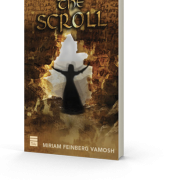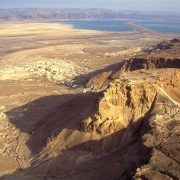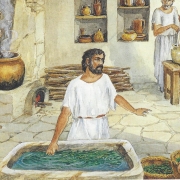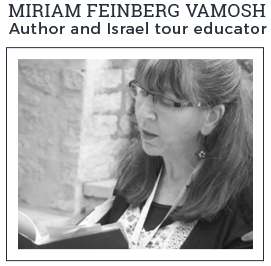Riding the Lion
Riding the Lion
What was – what is – the siren call of the rebel movement that began at Masada and effectively ended with the Bar Kokhba war, but continues to evolve to this day?
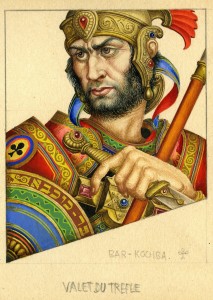
Bar Kokhba the fearsome warrior, by Arthur Scyzk (1927). Courtesy of the Eretz Israel Museum, Tel Aviv
What would you do if you were there, on the last, catastrophic day of the Roman siege of Masada, with your enemy at your gates? Would you have taken the lives of your family, as commanded by the Jewish rebel leader Elazar, to spare them captivity? And what of the generations that followed? Surely their forebears’ crushing defeat taught them that the sanctity of life outweighed all other considerations. These are some of the questions I explore in my historical novel “The Scroll.” And there they were – the very same, old-new questions that challenged me in “The Scroll” – in a striking new exhibit at the Eretz Israel Museum, Tel Aviv, “Bar Kokhba: A Historical Memory and the Myth of Heroism.”
The ancient Jewish sages are thunderously silent about Masada, on whose final moments the plot of “The Scroll” takes off on a multi-generational trajectory. And yet today, Masada is one of Israel’s flagship Israeli tourist sites and a UNESCO World Heritage Site to boot.

Aerial view of Masada. Courtesy of the Israel Tourism Ministry, www.goisrael.com
In contrast, the leader of the second revolt, some 60 years later, Bar Kosiba, has been a controversial figure, from his day to ours. You might know him better as Bar Kokbha, which means “son of a star” – to Rabbi Akiva he was the messiah himself. But the sages’ consensus about Bar Kokhba is best encapsulated in a Talmudic pun on his name – Bar Koziba – “son of a deceiver.”
And yet as the exhibit shows, as a symbol, Bar Kokhba, like Masada, was transformed over the generations. From the mid-19th century, in the hands of Jewish ideologues, artists, poets and playwrights he morphed into a musclebound, quintessential model of Jewish heroism. An 1840 novel published in Germany by Rabbi Shmuel Meir even depicted him defeating and riding a lion. The establishment of the State of Israel saw that symbol become even more deeply ingrained.
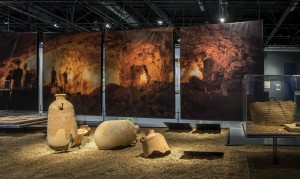
Archaeological finds from the Bar Kokhba period in Judean Desert caves. Notice the basket at right. Courtesy of the Eretz Israel Museum, Tel Aviv
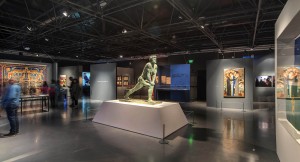
View of ther Eretz Irael Museum exhibit. The sculpture of the musclebound Bar Kokhba in the center is by 20th-century sculptor Chanoch Glicenstein. Courtesy Eretz Israel Museum, Tel Aviv.
Like “The Scroll,” the Bar Kokhba exhibit explores the idea that if your hero can ride a lion, the final outcome notwithstanding, words like “victory” and “freedom” take on new meanings.
The exhibit features rare film footage of the moments of discovery of human bones, in the Judean Desert “Cave of Horrors.” According to scholars the remains, carefully placed in woven baskets, were those of Bar Kokhba’s rebels and their families, starved to death by the Romans. But if the rebels all died, who put those skulls and bones in those baskets? That is a question asked – and answered – in “The Scroll.”

Vintage Shomer Hatzair Youth Movement Bar Kokhba Troop banner celebrating their hero, painting on silk. Courtesy of the Eretz Israel Museum, Tel Aviv.
Please visit the Menorah Books website to order your copy of The Scroll, and for a special 20% discount for friends and subscribers, please contact me. Thank you!

